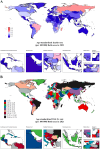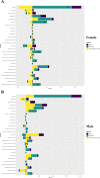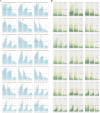Global Epidemiology of Early-Onset Aortic Aneurysm: Temporal Trends, Risk Factors, and Future Burden Projections
- PMID: 39945980
- PMCID: PMC11825438
- DOI: 10.1007/s44197-025-00369-y
Global Epidemiology of Early-Onset Aortic Aneurysm: Temporal Trends, Risk Factors, and Future Burden Projections
Abstract
Background: Aortic aneurysm has a subtle onset, high rupture mortality, rapid progression in younger individuals, and increasing annual mortality rates. Our study aimed to estimate the global burden and trends of early-onset aortic aneurysm from 1990 to 2021.
Methods: Participants aged 15-39 years from 204 countries and regions (Global Burdern of Disease, GBD) from 1990 to 2021.The primary assessment indicators include age-standardized death rates (ASDR), age-standardized disability-adjusted life years rates (ASDALYR), annual average percent change (AAPC), attributable risk factor proportions, slope index, concentration index, and predictive model for early-onset aortic aneurysm.
Results: From 1990 to 2021, the ASDR for aortic aneurysm in adolescents and young adults increased from 0.12 (95% confidence interval [CI] 0.11, 0.14) to 0.13 (0.11, 0.14) per 100,000 population, with an AAPC of 0.08% (-0.08%, 0.25%). The ASDALYR rose from 7.25 (6.52, 8.30) to 7.35 (6.51, 8.37), with an AAPC of 0.07% (-0.09%, 0.23%). Both ASDR and ASDALYR are higher in males than females, with a declining trend in females. Higher Socio-Demographic Index (SDI) countries exhibit higher ASDR and ASDALYR compared to lower SDI countries, with a continuous decline observed in high SDI nations. Smoking remains the top risk factor, with population growth being the primary driver. Models predict a global increase in aortic aneurysm deaths, predominantly among males.
Conclusion: The overall burden of early-onset aortic aneurysms has exhibited an increasing trend over the last three decades, especially in lower SDI countries. There is an urgent need to develop targeted prevention and control strategies across different regions and countries worldwide.
Keywords: Disability-adjusted life years; Early-onset aortic aneurysm; Epidemiology; Global burden of disease.
© 2025. The Author(s).
Conflict of interest statement
Declarations. Ethics Approval and Consent to Participate: Not applicable. Consent for Publication: Not applicable. Competing Interests: The authors declare no competing interests.
Figures






Similar articles
-
Disease burden of aortic aneurysm from 1990 to 2021 with a forecast to 2045: insights from the global burden of disease 2021.BMC Public Health. 2025 May 17;25(1):1829. doi: 10.1186/s12889-025-23067-7. BMC Public Health. 2025. PMID: 40382603 Free PMC article.
-
Global Trends of Early, Middle, and Late-Onset Lung Cancer From 1990 to 2021: Results From the Global Burden of Disease Study 2021.Cancer Med. 2025 Feb;14(3):e70639. doi: 10.1002/cam4.70639. Cancer Med. 2025. PMID: 39918236 Free PMC article.
-
Global trends in prevalence, disability adjusted life years, and risk factors for early onset dementia from 1990 to 2021.Sci Rep. 2025 Apr 18;15(1):13488. doi: 10.1038/s41598-025-97404-6. Sci Rep. 2025. PMID: 40251196 Free PMC article.
-
Temporal trends of particulate matter pollution and its health burden, 1990-2021, with projections to 2036: a systematic analysis for the global burden of disease study 2021.Front Public Health. 2025 Apr 16;13:1579716. doi: 10.3389/fpubh.2025.1579716. eCollection 2025. Front Public Health. 2025. PMID: 40308905 Free PMC article.
-
Global, regional, and national burden of asthma and atopic dermatitis, 1990-2021, and projections to 2050: a systematic analysis of the Global Burden of Disease Study 2021.Lancet Respir Med. 2025 May;13(5):425-446. doi: 10.1016/S2213-2600(25)00003-7. Epub 2025 Mar 24. Lancet Respir Med. 2025. PMID: 40147466
References
-
- Khan Minhas AM, et al. Global burden of cardiovascular disease attributable to smoking, 1990–2019: an analysis of the 2019 global burden of Disease Study. Eur J Prev Cardiol. 2024;31(9):1123–31. 10.1093/eurjpc/zwae040. - PubMed
MeSH terms
Grants and funding
LinkOut - more resources
Full Text Sources
Medical

